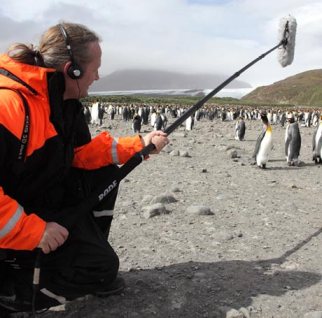Booming – involves attaching the microphone to a pole (boompole) and suspending it in front of the subject. This allows for considerable movement by actors. Booming is done by a boom operator – keep the mic as close to the subject, moving the mic from one subject to the next, keeping the mic out of the frame. The boom operator wears headphones so that he can hear/judge the sound.
Shock Mount – the mic is attached to the boompole using a sock mount that suspends the mic in a rubber band-like webbing – it prevents vibration from travelling up the boompole to the mic.
Overhead booming – The mic is normally positioned several inches to a foot over the actors head – the further the mic is away from the subject, the greater the background noise and echo. Overhead booming provides the most natural sounding dialogue with the least amount of mixing. It allows multiple actors to be recorded with a single pie, yielding a pleasant blend. Sufficient sound effects are picked up to give the soundtrack a full texture.
Underneath booming – when booming from underneath, the mic is suspended below and slightly ahead of the subject. It has more drawbacks, compared to overhead booming – dialogue tends to be bass heavy, it’s closer to the actor’s hands.
Pistol grip – used in tight spaces where a boompole is impractical
Plant – is any microphone fixed in place, used to cover a static subject when impractical to use a boom. Plants can be conventional condenser mice or lavalieres.
Lavaliere – calls lavs for short, tiny microphones worn on actor’s body. They dominate the sound track, less natural audio, you can hear contact noise of clothing etc.




